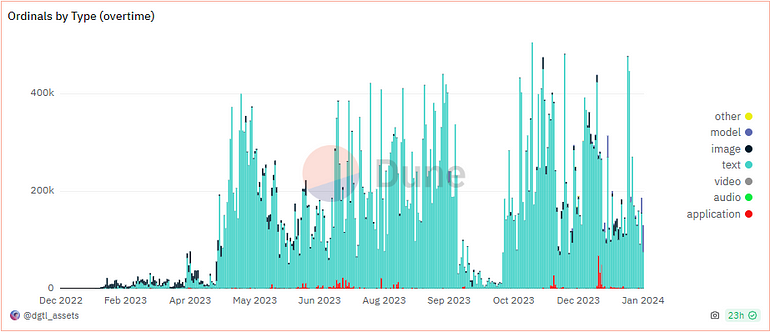🌍Bitcoin Evolves: A Brief Overview of BRC-20 Tokens, Ordinals, and Inscriptions

Inrecent weeks and months, with the beginning of BRC-20 tokens, terms like Ordinals, Atomicals, and Inscriptions have become increasingly common. As inscriptions increase in market capitalization and branch out into new ecosystems, it triggers an important question: is it necessary for us to understand not only the meaning of these terms but also the technical foundations of this emerging technology?
Understanding Bitcoin’s Inscriptions and Ordinals
Inscription ordinals represent the smallest unit of Bitcoin, known as Satoshis. Functioning as unique serial numbers for Bitcoin, these ordinals allow for the tracking of each unit’s history. They provide detailed insights into when the Bitcoin was mined, its ownership history, and the frequency of its transfers. The rarity of some satoshis is influenced by factors such as the timing of their mining, the miners involved, and specific dates associated with their creation. Inscriptions, a more recent innovation, offer a method for embedding information directly onto the blockchain.In the Bitcoin world, the concept of inscriptions was pioneered through Ordinals. This innovative approach allows the integration of various types of data — such as text, images, audio, or video — directly onto each individual satoshi, also known as ‘sat.’ These inscriptions become a permanent part of the Bitcoin blockchain, existing independently without reliance on any third-party middlemen.When you embed your personal data onto a satoshi, it is assigned a distinct numerical value, essentially serving as a unique numerical label. This process creates the satoshi ‘non-fungible,’ indicating the specific timestamp when your data was added. For instance, data inscribed a month ago would have a lower inscription number compared to something added today. Typically, lower numbers are regarded as more rare, adding to their uniqueness and value in the crypto space. Initially emerging as a type of NFT, Inscriptions and Ordinals have since evolved, leading to the development of the BRC-20 standard. This innovation addresses Bitcoin’s native inability to create fungible tokens. © by Dune & @dgtl_assets
© by Dune & @dgtl_assets
According to the Dune Dashboard created by @dgtl_assets, there has been a sustained high level of Ordinal deployments each month, consistently since May 2023. While the focus has mainly been on texts and images, I expect that a variety of other data types will be used in the future.
Structure of BRC-20 Operations
The structure of Ordinals during deployment is always identical and can be outlined as follows. The structure for mint and transfer Ordinals are very similar. Operations like Deploy, Mint and Transfer transfers follow to a first-come, first-served principle. Specifically for Deploy deployments, in cases where a BRC-20 token of the same name is deployed, only the first deployment is recognized as successful.
{
"p": "brc-20",
"op": "deploy",
"tick": "ordi",
"max": "21000000",
"lim": "1000"
}Below is a short explanation of the keys and their meanings: Today marks the launch of SARC-20, the inscription token protocol on SatoshiVM, currently available on Testnet. If you’re interested to explore the world of Inscriptions and explore this innovative domain, the Testnet environment provides an ideal playground for experimentation and discovery.
Today marks the launch of SARC-20, the inscription token protocol on SatoshiVM, currently available on Testnet. If you’re interested to explore the world of Inscriptions and explore this innovative domain, the Testnet environment provides an ideal playground for experimentation and discovery.
Impact of Inscriptions
Inscriptions find their most engaging use cases on blockchains that lack native support for NFTs, such as Bitcoin, Celestia, and Cosmos. However, their popularity has exceeded these chains and extended to others like Solana, Avalanche, and even the Ethereum mainnet. The surge in inscriptions adoption contributed to increased transaction fees and network congestion on chains like Avalanche and Arbitrum towards the end of last year. One of the notable advantages of inscriptions is their ability to directly store images on the blockchain. In contrast, the majority of NFTs are typically hosted on centralized servers rather than being on-chain.
Inscriptions on Cosmos
The adoption of this approach has extended to multiple blockchains. Inscriptions have become essential for trading NFTs or fungible tokens on the Bitcoin network, unlike some other blockchains where this requirement doesn’t exist. However, the speculative passion in the market has driven the increasing popularity of inscriptions across various Layer 1 and Layer 2 solutions.Recently, Asteroid Protocol made its debut with the backing of Delphi Labs and Astroport, a platform within the Cosmos ecosystem. Asteroid Protocol introduces inscriptions and CFT-20s (Cosmos Fungible Tokens) to the Cosmos Hub. Also, similar to Bitcoin, the Cosmos Hub lacks the capability to support smart contracts.Delphi Digital and Astroport, aim to leverage this limitation as a strength. While not a simple replication, Asteroid Protocol can be compared to what Ordinals represents for BTC but tailored for $ATOM.
Conclusion
In summary, while exploring the technical details of inscriptions and ordinals may not be required for everyone, recognizing their importance and their potential to reshape blockchain ecosystems is crucial. These innovations could transform how we engage with cryptocurrencies and blockchain tech, making them a valuable area to explore in the dynamic world of crypto.






































